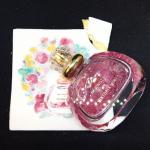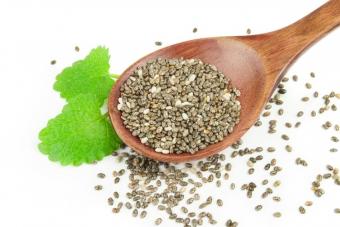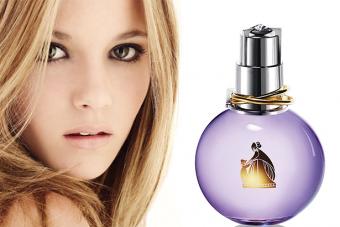
Do you like dogs? Then this post is for you. Our favorites are so faithful, so obedient, so smart, let them be smart and beautiful too! Moreover, inyazat for your pets is a great, incomparable pleasure!
1:946 1:953
Owners of dogs of small breeds are especially close to the topic of clothing for their pet!
2:16102:4
Here is an example of a sleeveless jacket for a small dog
2:93


Vest with fringes
5:58You will need:
50 g of beige yarn, 20 g each of brown and terracotta (100% wool, 250 m / 100 g), straight or circular knitting needles No. 2.5, crochet hook.
Knitting density:
elastic band 2 × 2 30 p. \u003d 10 cm, front surface 25 p. \u003d 10 cm, 40 p. = 10 cm.
Loop calculation
Take measurements from the dog and calculate the number of loops.
neck girth- 21 cm (63 p. + 2 cr. p. \u003d 65 p., round up to 66 p., since their number must be a multiple of 3); 1/3 girth ~ 7 cm (21 p. + 1 p. for the symmetry of the gum 2 × 2 = 22 p.); 1/12 girth ~ 1.8 cm x 2 = 3.6 cm (11 p.) - armhole width at the beginning of knitting.
5:1020Bust- 35 cm + 2 cm for a loose fit = 37 cm (111 p.); 1/2 girth (width of the back and tummy) - 18.5 cm each (56 p.)
5:1233 5:1238R distance from the withers to the middle of the back- 11 cm.
5:1328 5:1333armhole height: distance from the base of the neck to the end of the front paw + 1 cm = 7 cm (28 p.)
5:1488Armhole depth: for small dogs 2 cm (6 p.). 1/2 chest circumference - 1/3 neck circumference - armhole depth = 18.5 cm - 7 cm - 4 cm (2 cm for each armhole) = 7.5 cm (18 p.); 18 p.: 2 = 9 p.; Therefore, when knitting armholes, add 9 sts from each edge of the tummy and back.
5:19635:4
To find out how many rows to add loops, divide the distance from the base of the neck to the end of the front paw + 1 cm by the number of loops added: 7 cm = 28 p.; 28 p.: 9 p. = 3 p. This means that yarn overs must be made along the edges of each 3rd p.
5:423 5:430Back/tummy
5:464Cast on 66 sts with a beige thread. With a 2 × 2 elastic band, tie a collar 12 cm high, making strips of the same width with dark brown and terracotta yarn. Bind off 11 sts, knit 22. (tummy), bind off 11 sts, knit 22 faces. (back).
5:869Flip knitting: knit 22 out. (back), then take the thread from the second ball and knit 22 out. (tummy). You can collect the loops of one part on a knitting pin and knit later.
5:1212 5:1217Next, knit the back and tummy 28 p. stitch, making yarn over the edges of each 3 p. (9 times). The volume of parts will increase by 18 sts. Knit the first and last 3 sts in garter stitch so that the edges do not wrap. Then, along the edges of each part, dial 7 air. p. (armhole depth = 6 p. + 1 cr. p.). Now in each part there are 54 sts (22 sts + 18 sts + (2 × 7 sts), but you need 56 sts (18.5 cm). Add the missing 2 sts when switching from knitting to elastic 2 ×2, yarn over evenly spaced 2. Rib 2×2 work another 4 cm, making colored stripes as on the collar.
5:2180 5:6Assembly
Sew the details of the sleeveless jacket and use a crochet hook to make a fringe on the collar from dark brown and terracotta yarn.


Clothes without seams
8:2


Clothes with a hood
10:1063 10:1066
11:2

It is knitted by adding and decreasing loops in the right places.
12:629Measuring the circumference of the neck
Bust
Waist
Leg circumference
The distance from the "collar" to the paws of the dog
Naturally, each dog has its own size.
12:928Calculate loops. The yarn is different.
We collect loops on knitting needles equal to the girth of the neck.
We knit a collar.
12:1125After the collar, we divide the knitting into three parts. It depends on where the fastener will be. If on the belly, then approximately 15 loops on the sides and everything else is the back.
12:1422The number of loops depends on the density of the yarn (threads)
We add in each 2nd row one loop to the center from the sidewalls.
So we knit to the paws. Before the start of the hole for the paws.
12:98 12:261Then these three parts are connected and knitted together. Approx 3 cm.
Then we begin to decrease the loops in the middle of the hole for the legs. Approximately two loops in every 4th row.
And so, until the end of knitting. I get 35-36 cm from the neck to the brace with an elastic band.
Well, the design, as a fantasy, will tell you!
It is tied with an elastic band with stocking knitting needles for armholes, straps.
You can make holes for tassels after knitting the collar and stretch the cord with tassels, etc.
For girls, I knit the belly to the end of the canvas, for boys it is better 8 cm from the armholes and close the loops. Continue the required distance only in the central part - the back. Everything is individual and needs to be measured. To sit nice!
12:1558 12:4Hood can be knitted as a heel to sock. Make it removable with buttons or ties.
12:175 12:182Knitted dog sweater
12:236 12:239


Here is the principle of knitting these sweaters and the basic pattern!
15:119We knit these sweaters from the collar. Calculate the number of loops for the gate. If it is high with a lapel, increase its length by 2 - 4 cm so that after stitching the product, the collar does not squeeze the neck. Also add loops for symmetry, for example, when sewing the edges of a collar knitted with an elastic band 1 × 1, 1 front and 1 wrong loop must be joined, otherwise the seam will be noticeable.
15:786 15:793So that the sweater can be worn over the collar and at the same time fasten the leash without any problems, make a hole in the collar for the collar ring. To do this, when knitting the penultimate row of the gate in the place where the middle of the back will be, close 3-5 loops in a row, and in the next row dial the same amount of air. When the collar is ready, divide the knitting into two unequal parts: 1/3 loops - the tummy, 2/3 loops - the back. They can be knitted at the same time from two balls or collect the loops of the tummy on a knitting pin and knit it later.
15:1773 15:6 
The depth of the armhole depends on the size of the dog.
16:670 16:675For small dogs(Yorkshire Terrier, Toy Terrier, Chihuahua) it is 1 - 1.5 cm,
16:833for medium(poodle, dachshund, jack russell terrier, white terrier) - 2 - 2.5 cm, for larger dogs- 3 cm or more.
16:1042 16:1047To find out the height of the armhole, measure the girth of the front leg, add 1 cm, calculate 1/2 of the girth and subtract from it twice the depth of the armhole. If you plan to trim the armholes with an elastic band, then increase their height and depth by 1 cm. After both parts of the sweater are ready, sew them: first, sew the shoulder seams (sewing the edges of the collar), and then the side seams.
16:1705For details on how to calculate loops for a sleeveless sweater, see the description of the sweater.
16:179 16:186Sleeveless dog sweater "Heart"
16:273There are two ways to reduce the width of the back:
1. Smoothly: knit 2 loops together along the edges of the back in every second front row;
2. Sharply: knit 2 loops together along the edges of the back of the fabric in each front row.
The edges of the back, knitted with front surface, wrap and spoil the appearance of the product. To prevent this from happening, by knitting the back to the length of the tummy, knit the first and last 3-4 loops with a garter stitch (that is, all rows of faces. p.).
16:1069With any pattern, the last 1.5 - 2 cm of the back is best knitted with an elastic band. Then the product will take on a finished look, and the back will not lift up. If there are voluminous braids in the pattern, then when switching to an elastic band, knit all braid loops 2 loops together
16:1511 16:6 
1 - 1/3 neck girth;
2 - 2/3 neck girth;
3 - the distance from the base of the neck to the front paw (this measurement is inaccurate and serves to calculate the approximate number of crochets along the edges of the parts);
4 - distance between the front paws + 2 cm (allowance for armholes);
5 - back width = (chest girth + 3 cm) - (distance between front legs + 2 cm);
6 - length of the tummy = distance from the base of the neck to the middle of the abdomen or to the hind leg);
7 - back length;
8 - the height of the armhole of the front paw girth increased by 1 cm (or by 2 cm if the girth is very small) - the depth of the armhole x 2;
9 - armhole depth = 1 - 3 cm (depending on the size of the dog). If you plan to trim the armhole with an elastic band, increase its height and depth by 1 cm.
If the distance from the base of the neck to the beginning of the front paw (measurement 3) is more than 3 cm, then the vertical distance from the collar to the beginning of the armhole (b) may not correspond to the value of measurement 3, since it goes along an oblique (a). That is, the actual number of rows will be less than the number that you get when calculating the loops on a regular sample of 10 × 10 cm. To make the correct calculation, knit the sample by knitting at the end of the front rows, or calculate the yarns approximately: if measure 3 is 3 cm, make 3 - 4 yarn overs, one from each edge of the front rows of the fabric, 4 cm - 5 yarn overs, 5 cm - 6 yarn overs, 6 cm - 7 yarn overs, 6.5 cm - 8 yarn overs.
17:1150 17:1157
Here is another version of knitted clothes for our kids!
the simplest thing you can think of.
18:168 
You will need:
100 g of brown melange yarn (50% wool, 50% acrylic, 280 m / 100 g), knitting needles No. 2.5, brown buttons (5 pcs.), Needle with a wide eye.
Knitting density:
gum 2 × 2 26 p. \u003d 10 cm, 28 p. = 10 cm,
garter stitch 25 p. = 10 cm.
Loop calculation
Take measurements from the dog and calculate the loops.
Length of the product- 25 cm.
Bust- 53 cm (137 p. - 1 p. for the symmetry of the gum 2 × 2 = 136 p.)
neck girth- 30 cm (78 p. + 2 cr. p. = 80 p.)
Distance from the base of the neck to the front paw- 7 cm (20 rubles)
Front leg circumference- 20 cm; 1/2 girth - 10 cm, 1/6 girth (armhole depth) = 3 cm (8 p.), Therefore, 136p. - (8 p. x 2) = 120 p.; 120 p. : 3 \u003d 40 p. (15 cm) the width of the tummy and each shelf
Armhole Height: 10 cm - 3 cm (armhole depth) = 7 cm (20 p.)
Plank (2 pcs.) - 25 cm = 62 p.


Work description
Cast on 136 sts and work 11 cm (30 p.) Rib 2x2. Then knit 40 sts (first shelf), close 8 sts (armhole), knit another 40 sts (tummy), close 8 sts again (armhole), knit the remaining 40 sts (second shelf).
Flip knitting and knit 40 p. of the second shelf, then take the thread from the second ball and knit the loops of the tummy, then with the thread from the third ball - the loops of the first shelf. Thus, knit 20 p. Then dial 8 air. n. over closed loops. Knit in a straight line 1 cm (3 p.). Then, in three steps, begin to decrease the loops: 136 p. - 80 p. = 56 p.; 56 p.: 3 \u003d 18 p. So, at a time you need to reduce 18 p.:
21:21611st row- with an elastic band 2 × 2, 2 p. Vm. every 7 p.;
2nd, 3rd, 4th rows- according to the drawing;
5th row- with an elastic band 2 × 2, 2 p. Vm. every 6 sts;
6th, 7th, 8th rows- according to the drawing;
9th row- with an elastic band 2 × 2, 2 p. Vm. every 5 sts
Knit the remaining 8 p. in a straight line and close the hinges. Cast on 62 sts for plank and work 2.5 cm in garter stitch. On the other bar, make five buttonholes at regular intervals. Sew the straps to the sweatshirt shelves. Sew buttons on one of the straps. Quilt the collar from the inside with rubber thread in 2-3 rows.
CHILDREN - DAX - a sweater for you!
21:1013(shortening the length of the back - we adjust to the size of your dog)
21:1134As a rule, it is difficult to calculate a sweater for a taxi. it has non-standard measurements….. the simplest calculation for you:


such a wonderful sweater - very comfortable to work with ... .. let's start.
23:650 23:655*So, to knit a dachshund sweater, we will need from 50 to 200 g of yarn (depending on the size of the dog), a set of stocking needles (5 pcs.) And circular knitting needles of 2 numbers, usually No. 3 and 3.5 or 4, depending on the thickness of the yarn.
23:1040* Measuring the circumference of the dog's neck in the place where a tightly worn collar is usually located and cast on the required number of loops on smaller needles. We close the knitting in a ring and knit the required number of rows around the neck (in this example, the neck is tied with a double elastic band)
23:1576 23:6
Next, we distribute the loops by trying on our neck on the dog. I took the same number of loops on the back and breast, 3 loops on the sleeves and 6 loops on the raglan lines (4 p. braids and 1 out. loop on the sides of it). I knit the sweater in stockinette stitch.
24:978 24:1239 24:1246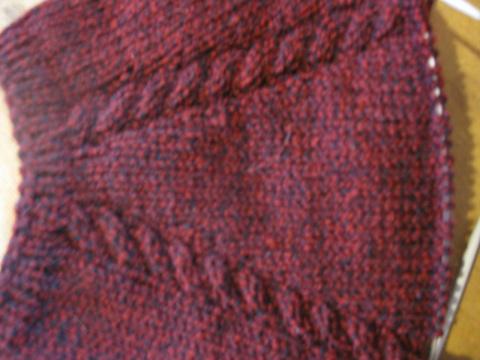
At the same time, we reduce the loops for the breast between the legs
25:121 25:128 
Then we remove the loops of the back and sleeves on knitting needles with a fishing line (you can use a strong thread) and knit the breast in straight and reverse rows
26:873 26:880
This is necessary for a good fit of the sweater, because the breast in taxi clothes should be much longer and more voluminous than the back, in the process of knitting the breast we add loops so that the breast and back come together around the elbows:
27:1784 27:6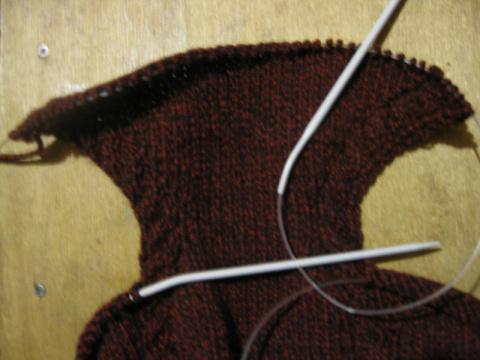
We leave the loops of the sleeves on knitting needles with fishing line:
28:618 28:625
We combine the loops of the breast and back, knitting the extreme loops so that between the halves of the braid we get 1 out. loop and knit in a circle torso, if necessary, to the waist we reduce the extra loops of the tummy:
29:1513 29:6


something like that…….
32:36 32:43Clothing for dogs is not a luxury, but an absolute necessity in the cool season! But who am I kidding? What a luxury! Of course, clothes for dogs, especially those of a fragile physique, are primarily protection from cold, wind and drafts, but how do you want the dog to look stylish and cute in his warm sweater or overalls.
And to the topic of luxury, I’ll add that at all times, handmade was very much appreciated, and there was no more luxury than a dress sewn by hand, trimmed with lace woven by skilled craftswomen. Therefore, by creating things with your own hands, you make your contribution to art, and also make this world warmer and more comfortable!
I suggest that you start honing your skills on clothes for your beloved pets. Consider how to knit a sweater for a dog, decorated with hearts. This is one of the easiest ways, with few measurements, and no pattern. Or according to the pattern, knit with a pattern ““.
Let's get started!





We catch our dog and take a few measurements.
- neck girth (OSh);
- chest width (SHG);
- paw girth (OL);
- length, from the withers to the beginning of the tail (D).
For work, we need stocking knitting needles or, if the dog is not quite a baby, then also circular ones. And, of course, we knit a sample with knitting needles to calculate the number of loops, according to the measurements that you took. Yarn will need two colors, better contrasting. For girls, white and pink are well suited, and for my brutal, but very shy macho, I took gray and red yarn.



Neck and raglan
We start knitting a sweater from above, from the neck. We calculate the number of loops based on the measure of the OSH. In the case of our example, the loops turned out to be 64. We distribute them on four knitting needles, and knit with an elastic band 2x2 15 rows. It can be less, but it can be more to make a lapel. The smaller the dog, the more the sweater should fulfill its function - to warm. Therefore, the collar may be higher, the sleeves, and the sweater itself may be longer.
Divide the number of elastic loops by 3 and distribute the resulting amount between the back, breast, and paws. Example:
64:3~22. The back of the dog is wider than the chest, so we will assign 25 loops to this part, 19 to the chest, and 20 to the paws, 10 per paw. How to do this exactly, you will understand if you carefully look at your dog, at the proportions of his body. Much depends on the fullness, thinness, and characteristics of the breed. There is no exact formula for all dogs, you, as the owner of your pet, will not be difficult to calculate this simple formula.
Having distributed the loops, we put markers, or we knit threads of a contrasting color.
When there are 2 buttonholes left before the first marker, yarn over, then knit two wrong ones, throw the marker, again two wrong ones, and again yarn over. And so, with each marker.
 Thus, the product begins to expand.
Thus, the product begins to expand.
And here is the first heart on our dog sweater. It will be on the chest. It can be placed in the center, or it can be shifted to any side.
Why inverted? For your convenience, as we knit from above!
We put the first strokes of the heart.
We continue to knit raglan, and do not forget about the heart.
Sleeves
At this stage, you can try on the product on the dog, so that it becomes clear how it "sits" in the shoulders and that it's time to leave room for the sleeves.
To be sure, we will calculate the number of loops for this part, according to the measurement of OL and check the size of the chest, according to the measurement of WG.
This is where the sleeve will be.
We transfer the loops of the sleeve to another knitting needle and leave it for now. In the meantime, we will continue knitting in a circle. We will cast on the working knitting needle from 5 to 10 loops, so that there is no too tight fitting of the sleeve, so as not to hinder the movements of your active friend. We close the circle and continue knitting.
Body
On the back, we will perform another jacquard pattern - two hearts. The location and size of the picture, you can choose any. If suddenly, your dog is just a baby and such a pattern simply does not fit on its back, you can knit one heart from this or the previous pattern with knitting needles.


Following the scheme, we get such a pattern.
Having finished knitting the pattern, we continue knitting in a circle. The length of the product must be chosen based on the size of the dog, but the length along the tummy should be shorter than the length of the back.
Having decided on the length, we continue knitting with an elastic band 2x2.
Having knitted about 7 rows of elastic, we close only the tummy area.
The next step is closing the loops on the back. Knitting is transferred to one knitting needle, and we knit the front and back rows, knitting at the beginning and end of each row three loops together. So the back will be gently rounded. If your dog's body is long enough, then you can knit two loops, and not in each row, but through the row, so the back will be longer.
So that decorative dogs do not freeze during a walk in winter, many owners knit clothes for them.
I decided to show how to knit the simplest and most ordinary jumpsuit. On the basis of such a jumpsuit, you can knit anything.
Before knitting, you need to take measurements from the dog. And knit a sample to calculate the density of knitting.
Picture from the Internet.

1. 44 cm (4 cm on the stomach)
2. 30 cm
3. 28 cm
4. 32 cm
5. 10 cm
6. 20 cm
7. 12 cm
The jumpsuit is knitted from head to tail in one piece, without thread breakage. You will need: Straight needles, circular needles and crochet hook. Threads p / w 100 grams = 250 meters.
We will knit according to the principle of raglan from top to bottom.
Cast on as many stitches as you need for the neckline. I have 65 loops And knit with any elastic band that is convenient for you. I have 1*1
Next, we divide the loops into 5 parts: left shelf, left shoulder, back, right shoulder, right shelf. I divided it like this: 14p. left shelf, 3p (1 out., 1 person., 1 out) - raglan line (hereinafter RG), 3p. left shoulder, RG, 27p. back, RG, 3p. right shoulder, RG, 14p. right shelf. And we knit a regular raglan from top to bottom, adding 1 loop on both sides of each RG in each front row.
We knit to the armpits of the front paws. We transfer knitting to circular knitting needles.
We knit the loops of the left shelf, removing them on the right circular knitting needle.
RG, loops of the left sleeve, RG we knit with facial loops with a straight knitting needle. Now we have the loops of the left sleeve on the straight knitting needle, and the rest on the circular ones.
We close the loops, DO NOT cut the thread.
We fold the sleeve inside out and crochet the sleeve to the armpit (the junction of the front and back) starting from the last loop of the closed row.
We connect the left shelf, the last loop of the closed sleeve, dialing between them 2 loops from the loops of the previous row, we collect two loops from the loops of the previous row between the last loop of the closed sleeve and the back, we knit the loops of the back with CIRCULAR knitting needles to the RG. We knit the RG, the right sleeve and the RG in front of the right shelf with facial loops with a straight knitting needle. Thus, we have on circular knitting needles the left shelf connected to the back and the right shelf. Knit the right sleeve according to the pattern of the left sleeve. We connect the back and the right shelf, not forgetting to get the loops in the armpit. Getting the top of the jumpsuit
From the armpits to the waist, we knit the shelves and the back at the same time. We knit the last few rows on the shelves with an elastic band. On the front side, close the loops of the left shelf, knit the back and right shelf, turn over, close the loops of the right shelf in the wrong row. Only back loops remained on the knitting needles
We knit the back to the beginning of the hind legs. And again we knit raglan, as for the front paws.
In the same way, we sew the cuffs with an elastic band.
 Human life is inextricably linked with the life of four-legged comrades. Every owner loves and cares about the pet. He does everything to make the dog happy. Owners of small breeds know that pug clothing is essential in winter and summer.
Human life is inextricably linked with the life of four-legged comrades. Every owner loves and cares about the pet. He does everything to make the dog happy. Owners of small breeds know that pug clothing is essential in winter and summer.
 A well-known fact, the pug is a beautiful breed of dog, but, unfortunately, having a short coat, which in severe frost will not be able to protect him.
A well-known fact, the pug is a beautiful breed of dog, but, unfortunately, having a short coat, which in severe frost will not be able to protect him.
Hypothermia of a dog negatively affects the state of its body. The immune system is weakening.
Also, the owners of this breed need to be extremely careful in the summer, because of the short coat, the dog risks suffering from sunstroke.
This is why pug clothing is a must. You can buy a pet wardrobe at the nearest pet store, through an online store, or make it at home.
The latter option will cost several times cheaper, and outfits made at home are valued more than purchased ones.
Now some needlewomen provide tailoring services for dogs. If you have never done this, it is better to order from a professional.
Buying outfits for a pet, the owners want the dog to look beautiful, stylish and fashionable. The main functionality of outfits for a dog is protection from various weather phenomena, coziness and comfort.
In the store, before purchasing a suit, you must try it on. It should not hinder the movement of the pug, it is better to measure the entire store, but choose a really worthwhile thing than buy a useless outfit that will later end up in the trash.
In cold weather, insulated overalls, a coat with fur inserts, and insulated boots are suitable for a pug. A hood that protects sensitive ears from the cold will be a great addition. The neck is covered with a scarf, self-knitted.
- In rain and sleet, the dog needs a raincoat. In hot weather - overalls, a suit made of cotton fabric and panama.
Dog wardrobe requirements
When choosing a costume, pay attention to the individual features of the body structure of the animal.
The structure of the pug is a large body and head, a powerful chest.
We conclude that clothes for pugs:
- Should not squeeze the area of the sternum and neck, hinder the movements of the pet;
- Should not cause irritation, rashes, allergies, carefully choose the material;
- Must be suitable for weather conditions.
What is included in the wardrobe
In the wardrobe of a four-legged comrade, the following elements may be present:
- Overalls
- Coat
- Jacket and trousers
- Sweater, vest, sleeveless jacket
- T-shirt
- Panama, scarf
- Shoes, socks
- Harness, collar
All this can be purchased at the nearest pet store, or you can make it yourself.
Make your own for your beloved dog
Do-it-yourself pug clothes are always positive emotions and an exciting process. Sewing, knitting or crocheting - all this will come in handy!
Vest
A hand-knitted vest looks good on a pug. The technology for preparing the product will seem simple for experienced craftswomen.
First you need to make patterns and measurements with your own hands. Putting your soul, love and warmth into the product, you will create a unique image. With a little imagination, you can create a stylish outfit.
The ability to knit with different techniques will be a clear advantage. On the Internet, you can find various knitting methods, just type in the search engine "how to knit a pug vest with your own hands", and you will see many interesting options.
Overalls
Making your own jumpsuit is not difficult. If you have no experience or too little in needlework, but there is a great desire to sew something for your pet, then this is the most suitable option.
Patterns are drawn on paper, best in millimeters. The paper is applied to the dog, and if everything is in order, then the pattern is transferred to the fabric and cut out.
On a note! Buttons are inferior to zippers as they take longer to fasten and often come off.
The initial tailoring is followed by a second fitting, after which the jumpsuit is adjusted to the features of the dog's figure. You will need a little time, perseverance, threads, a needle and a jumpsuit is ready.
The material for the jumpsuit is chosen according to your taste and color. If desired, it is insulated. A wonderful, unforgettable, beautiful outfit for a pug is ready.
socks
The production of socks does not require cutting and measuring. It is enough to imagine that this is a heel from socks for people. Using various knitting methods, the wardrobe of a four-legged friend will be more diverse.
harness
For decorative breeds, the harness has become an integral part. Pugs are much more comfortable wearing this accessory than a collar.
The harness is sold at any pet store. It can also be made at home. To do this, all the necessary measurements are taken, a pattern is made, then a matter of technology.
What you need for the harness:
- Harness material (leather, nylon, tarpaulin, leatherette, and synthetic fabric).
- Lining material.
- Soft webbing.
- Fastening ring.
fashionable doggy
Clothing for miniature breeds is distinguished by a variety of colors and styles. Use interesting patterns, patterns and the pet will be the most beautiful and unique.
You can buy clothes from fashion designers, or you can make it yourself.
When creating sketches for a dog, you can fantasize, come up with incredible combinations of colors, make it as comfortable as possible for your pet. You can also add colorful bows, collars for every day, funny outfits, funny hats, even bright ties and bow ties.
Dog clothes can be an absolute copy of the owner's clothes, creating harmony and idyll. It looks incredibly stylish.
Remember that clothing should not hinder movement, it should be comfortable, cozy and comfortable. Then your dog will not be stubborn when changing clothes. Buy outfits from the pet store or make your own. Hand-sewn clothes look much better than store-bought ones. Create, create and love your four-legged friend.
In winter, dog owners try to protect their pets from the cold by dressing them up in amazing outfits. Overalls for dogs, especially for small puppies just right. In what only overalls do not run four-legged friends in the snow. True, the price of these clothes is quite high, and not everyone can afford such a purchase. But any needlewoman can sew a winter outfit, the main thing is that a pattern of overalls for a dog and all the necessary materials are at hand. Such a product will look even more refined than store options.
In winter, dog owners try to protect their pets from the cold by dressing them up in amazing outfits.
This outfit is suitable for both a cocker spaniel girl, a bulldog, and a labrador. The main thing is to make all measurements correctly so that the pet is not only warm, but also comfortable in such attire.
Building a pattern and sewing step by step:
- First of all, you need to measure the length of the back from the neck to the base of the tail.
- After that, build a pattern grid. For this purpose, the resulting value is divided by eight. This will be the size of the grid square.
- Transfer the pattern to paper and cut it out.
- Transfer each detail to the fabric, not forgetting the seam allowances.
- Cut and sweep, stitch.
- Process the legs, insert elastic bands.
- The neck and back of the overalls are also processed and pulled in the elastic.
- Sew the flaps for the fastener and sew on a wide Velcro.
How to make a do-it-yourself jumpsuit pattern for a small dog (video)
How to sew a jumpsuit for a Yorkie with your own hands
The miniature overalls model is designed for small dogs. Suitable for both Yorkshire Terrier and Toy Terrier. The tailoring is quite simple. The main thing is just not to make a mistake with the sizes.
Master class on cutting and sewing:
- Take measurements: the length from the neck to the base of the tail, the girth of the neck, the wrists of the front and hind legs, the volume of the hips and the place where the front legs pass to the shoulder blade.
- Additionally, measure the circumference of the waist and chest.
- Based on the data obtained, make a pattern, while not forgetting about the hole for the tail.
- Transfer the finished pattern to the fabric, cut everything out and immediately baste.
- Try on the blank on the animal and, if necessary, correct inaccuracies.
- Stitch all the details together.
- Sew on a zipper.
- Insert elastic bands into the cuffs, collar and opening at the back.
- Additionally, decorate the jumpsuit with a pom-pom imitating a snowball, sew on small pockets.

The miniature overalls model is designed for small dogs.
Overalls for dachshund
Beginners are not recommended to start tailoring complex clothes. It would be best if the first job was to make blankets. In such a dress, the dog will not be cold. A funny product is sure to attract the attention of others.
Progress:
- Put the pattern on the fabric from the wrong side and circle it with chalk.
- Cut, but make allowances about a centimeter around the entire perimeter.
- Sew on a piece of fabric measuring 11x17 cm for the breast.
- On the back of the blanket, grind off the tucks.
- Flip around the edge of the workpiece.
- Sew Velcro on the side and on the chest.

In this dress, the dog will not be cold

Tip: if you plan to wear clothes in the winter, you need to additionally cut out a lining from the padding polyester.
Pattern of overalls for a dog-boy
Features of the cut of a dog outfit directly depend on the gender of a four-legged friend. That is why it is so important to choose the appropriate pattern. This overall is suitable for both large breed dogs and small and medium-sized animals. It can be used as a regular raincoat. If you equip your clothes with a warm lining, then in winter your pet will feel comfortable in it.
Progress:

- Take all measurements and cut the material.
- Immediately sew the hood to the neck, additionally insert an elastic band.
- Fold the details of the visor right sides to each other and sew.
- Turn them right side out and work along the edge, which is curved.
- Overlap the straight edge.
- Sew the visor under the edge of the front of the hood, directly along the groove.
- Sew the side elements and the tummy.
- Only after that sew on the sleeves.
- Stitch the cuffs and pull the elastic bands into them.
At the final stage, sew on a zipper.
How to sew a snowsuit for a chihuahua
An unusual jumpsuit can be sewn not only for a Chihuahua, but also for a pug, spitz, poodle and other medium-sized dogs. Visually, this outfit resembles a coat. Having dressed up an animal in such clothes, you can not be afraid that it will be cold on a walk.
Progress:

- Take the necessary measurements and draw a diagram on paper.
- Fold the fabric in half and cut out two halves of the future product from it. At the same time, be sure to make small allowances for the seams.
- Similarly, cut out the details of the lining.
- Sew the outer parts with the lining, leaving only the sleeves unfinished.
- Sew a strip along the bottom, the width of which should correspond to the width of the chest.
- Sew one of the upper seams with a strip, and sew a zipper into the remaining one.
- Knit a neat collar and sew it to the hem.
- Connect all remaining parts.
Tip: Sleeves should not be short. Better if they were a little longer. The cuffs equipped with elastic bands will not allow the fabric to fall, and the animal will be much more comfortable in loose clothing.
Overalls for a miniature dog made of terry socks
From a pair of ordinary socks, you can make two original overalls at once, each of which will be special and very comfortable. Even without sewing skills, making such outfits will turn out without the slightest problem.
What is necessary:
- socks;
- yarn for knitting "Grass";
- elastic threads;
- needle;
- hook;
- paper;
- ruler.
Progress:
- Put the toe with the heel up and draw a center line from the center of the heel to the toe.
- After that, draw a perpendicular line at a distance of about three centimeters.
- Measure ten centimeters from this line and draw another segment.
- On these perpendicular lines, mark the places of future holes for the paws.
- On paper, make a template for future holes by drawing a pair of circles with a diameter of three centimeters and a pair of ovals, the diameter of which should be 6x3 centimeters.
- Fix the templates with threads in the designated areas on the fabric.
- Fasten the jersey along the perimeter of the template with an elastic thread with a machine seam so that the fabric does not fray.
- Cut holes and remove templates.
- Using a hook and yarn, tie all the holes, making the usual double crochets.
- Try on the animal blank and mark with chalk all the necessary holes.
- Process them and cut them in the same way as in the case of cuts for the paws.
From the second sock, make a similar jumpsuit, but additionally tie the sleeves, carefully cut through and process the holes for the ears with high quality.
We cut a warm jumpsuit for a dog (video)
As a material for overalls, you can use not only fabric, but also genuine leather, as well as sew from old clothes that have not been worn for a long time. In this case, the dog will look incredibly stylish and original. If the main goal is to prevent the animal from freezing, then it is better to resort to the use of more practical materials. the hostess can sew for her devoted friend not only a jumpsuit, but also a suit, a vest, various jackets, in which the dog will be warm. You can download the pattern on the Internet. After work on clothes is finished, it's time to think about shoes.





